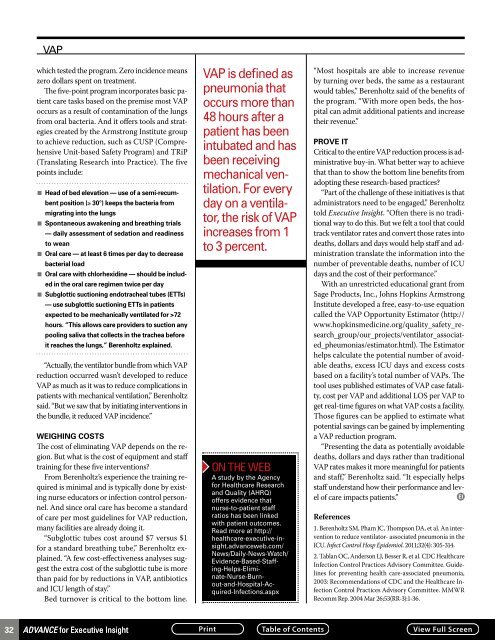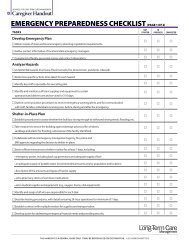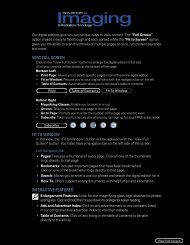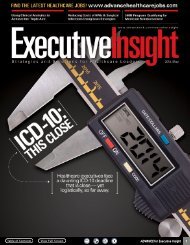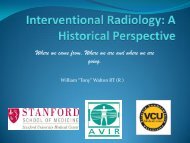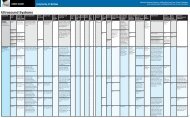ADVANCE for Executive Insight 1 ADVANCE for Executive Insight
ADVANCE for Executive Insight 1 ADVANCE for Executive Insight
ADVANCE for Executive Insight 1 ADVANCE for Executive Insight
- No tags were found...
You also want an ePaper? Increase the reach of your titles
YUMPU automatically turns print PDFs into web optimized ePapers that Google loves.
VAP<br />
which tested the program. Zero incidence means<br />
zero dollars spent on treatment.<br />
The five-point program incorporates basic patient<br />
care tasks based on the premise most VAP<br />
occurs as a result of contamination of the lungs<br />
from oral bacteria. And it offers tools and strategies<br />
created by the Armstrong Institute group<br />
to achieve reduction, such as CUSP (Comprehensive<br />
Unit-based Safety Program) and TRiP<br />
(Translating Research into Practice). The five<br />
points include:<br />
n Head of bed elevation — use of a semi-recumbent<br />
position (≥ 30°) keeps the bacteria from<br />
migrating into the lungs<br />
n Spontaneous awakening and breathing trials<br />
— daily assessment of sedation and readiness<br />
to wean<br />
n Oral care — at least 6 times per day to decrease<br />
bacterial load<br />
n Oral care with chlorhexidine — should be included<br />
in the oral care regimen twice per day<br />
n Subglottic suctioning endotracheal tubes (ETTs)<br />
— use subglottic suctioning ETTs in patients<br />
expected to be mechanically ventilated <strong>for</strong> >72<br />
hours. “This allows care providers to suction any<br />
pooling saliva that collects in the trachea be<strong>for</strong>e<br />
it reaches the lungs,” Berenholtz explained.<br />
“Actually, the ventilator bundle from which VAP<br />
reduction occurred wasn’t developed to reduce<br />
VAP as much as it was to reduce complications in<br />
patients with mechanical ventilation,” Berenholtz<br />
said. “But we saw that by initiating interventions in<br />
the bundle, it reduced VAP incidence.”<br />
WEIGHING COSTS<br />
The cost of eliminating VAP depends on the region.<br />
But what is the cost of equipment and staff<br />
training <strong>for</strong> these five interventions?<br />
From Berenholtz’s experience the training required<br />
is minimal and is typically done by existing<br />
nurse educators or infection control personnel.<br />
And since oral care has become a standard<br />
of care per most guidelines <strong>for</strong> VAP reduction,<br />
many facilities are already doing it.<br />
“Subglottic tubes cost around $7 versus $1<br />
<strong>for</strong> a standard breathing tube,” Berenholtz explained.<br />
“A few cost-effectiveness analyses suggest<br />
the extra cost of the subglottic tube is more<br />
than paid <strong>for</strong> by reductions in VAP, antibiotics<br />
and ICU length of stay.”<br />
Bed turnover is critical to the bottom line.<br />
VAP is defined as<br />
pneumonia that<br />
occurs more than<br />
48 hours after a<br />
patient has been<br />
intubated and has<br />
been receiving<br />
mechanical ventilation.<br />
For every<br />
day on a ventilator,<br />
the risk of VAP<br />
increases from 1<br />
to 3 percent.<br />
On the Web<br />
A study by the Agency<br />
<strong>for</strong> Healthcare Research<br />
and Quality (AHRQ)<br />
offers evidence that<br />
nurse-to-patient staff<br />
ratios has been linked<br />
with patient outcomes.<br />
Read more at http://<br />
healthcare-executive-insight.advanceweb.com/<br />
News/Daily-News-Watch/<br />
Evidence-Based-Staffing-Helps-Eliminate-Nurse-Burnout-and-Hospital-Acquired-Infections.aspx<br />
“Most hospitals are able to increase revenue<br />
by turning over beds, the same as a restaurant<br />
would tables,” Berenholtz said of the benefits of<br />
the program. “With more open beds, the hospital<br />
can admit additional patients and increase<br />
their revenue.”<br />
PROVE IT<br />
Critical to the entire VAP reduction process is administrative<br />
buy-in. What better way to achieve<br />
that than to show the bottom line benefits from<br />
adopting these research-based practices?<br />
“Part of the challenge of these initiatives is that<br />
administrators need to be engaged,” Berenholtz<br />
told <strong>Executive</strong> <strong>Insight</strong>. “Often there is no traditional<br />
way to do this. But we felt a tool that could<br />
track ventilator rates and convert those rates into<br />
deaths, dollars and days would help staff and administration<br />
translate the in<strong>for</strong>mation into the<br />
number of preventable deaths, number of ICU<br />
days and the cost of their per<strong>for</strong>mance.”<br />
With an unrestricted educational grant from<br />
Sage Products, Inc., Johns Hopkins Armstrong<br />
Institute developed a free, easy-to-use equation<br />
called the VAP Opportunity Estimator (http://<br />
www.hopkinsmedicine.org/quality_safety_research_group/our_projects/ventilator_associated_pheumonias/estimator.html).<br />
The Estimator<br />
helps calculate the potential number of avoidable<br />
deaths, excess ICU days and excess costs<br />
based on a facility’s total number of VAPs. The<br />
tool uses published estimates of VAP case fatality,<br />
cost per VAP and additional LOS per VAP to<br />
get real-time figures on what VAP costs a facility.<br />
Those figures can be applied to estimate what<br />
potential savings can be gained by implementing<br />
a VAP reduction program.<br />
“Presenting the data as potentially avoidable<br />
deaths, dollars and days rather than traditional<br />
VAP rates makes it more meaningful <strong>for</strong> patients<br />
and staff,” Berenholtz said. “It especially helps<br />
staff understand how their per<strong>for</strong>mance and level<br />
of care impacts patients.”<br />
References<br />
1. Berenholtz SM, Pham JC, Thompson DA, et al. An intervention<br />
to reduce ventilator- associated pneumonia in the<br />
ICU. Infect Control Hosp Epidemiol. 2011;32(4): 305-314.<br />
2. Tablan OC, Anderson LJ, Besser R, et al. CDC Healthcare<br />
Infection Control Practices Advisory Committee. Guidelines<br />
<strong>for</strong> preventing health care-associated pneumonia,<br />
2003: Recommendations of CDC and the Healthcare Infection<br />
Control Practices Advisory Committee. MMWR<br />
Recomm Rep. 2004 Mar 26;53(RR-3):1-36.<br />
32 <strong>ADVANCE</strong> <strong>for</strong> <strong>Executive</strong> <strong>Insight</strong>


